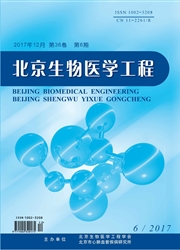

 中文摘要:
中文摘要:
目的灰度游程长矩阵参数可以反映图像纹理的粗细及均匀程度。本研究采用该方法研究阿尔茨海默病(Alzheimer’Sdisease,AD)患者脑MR图像中胼胝体的三维纹理特征,以反映AD患者胼胝体部位的病理变化,从而探索该纹理特征分析方法在该疾病诊断中的应用。方法选取18例AD患者及18例健康对照者,采用灰度游程长矩阵提取每位受试者胼胝体部位的4个三维纹理特征参数:短游程因子、长游程因子、灰度不均匀度和游程长不均匀度。比较两组间各纹理特征的差异,并分析这些纹理参数与临床广泛应用的简易智能状态检查量表(mini—mentalstateexamination,MMSE)评分之间的相关性。结果4个纹理参数两组相比较均有显著性差异,且与MMSE评分均具有相关性。结论基于三维纹理特征的灰度游程分析法能在一定程度上反映出AD患者胼胝体部位的病理变化,可能用于该疾病的临床诊断。
 英文摘要:
英文摘要:
Objective To explore the 3D texture features of corpus callosum in magnetic resonance images from the patients with Alzheimer' s disease and to discuss the application of texture features in diagnosis of AD. Methods T1- weighted MRIs of 18 AD patients and 18 normal controls were selected. 3D texture features of the corpus callosum, including short run emphasis, long run emphasis, grey level nonuniformity and run length nonuniformity, were extracted from the run length matrix. Finally, statistic significance was tested between the two groups, and the correlations between the parameters and the widely used method--mini-mental state examination (MMSE) were calculated. Results The differences of the 3D texture features were significant between the two groups, and they were correlated with MMSE scores. Conclusions 3D texture analysis can reflect the pathological changes of corpus callosum in patients with AD and may be helpful to the diagnosis.
 同期刊论文项目
同期刊论文项目
 同项目期刊论文
同项目期刊论文
 期刊信息
期刊信息
